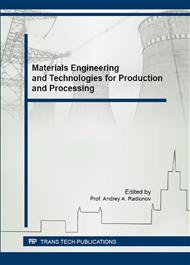[1]
C. de las Casas, W. Li, A review of application of carbon nanotubes for lithium ion battery anode material, Journal of Power Sources. 208 (2012) 74-85.
DOI: 10.1016/j.jpowsour.2012.02.013
Google Scholar
[2]
B.J. Landi, M.J. Ganter, C.D. Cress, R.A. DiLeo, R.P. Raffaelle, Carbon nanotubes for lithium ion batteries, Energy Environ. Sci. 2 (2009) 638-654.
DOI: 10.1039/b904116h
Google Scholar
[3]
Di-hua Wu, Zh. Zhou, Recent progress of computational investigation on anode materials in Li ion batteries, Front. Phys. 6 (2011) 197-203.
DOI: 10.1007/s11467-011-0186-z
Google Scholar
[4]
L. Wang, L. Ge, T.E. Rufford, J. Chen, W. Zhou, Z. Zhu, V. Rudolph, A comparison study of catalytic oxidation and acid oxidation to prepare carbon nanotubes for filling with Ru nanoparticles, Carbon. 49 (2011) 2022-(2032).
DOI: 10.1016/j.carbon.2011.01.028
Google Scholar
[5]
C.H. Mi, G.S. Cao, X.B. Zhao, A non-GIC mechanism of lithium storage in chemical etched MWNTs, Journal of Electroanalytical Chemistry. 562 (2004) 217-221.
DOI: 10.1016/j.jelechem.2003.09.004
Google Scholar
[6]
M.R. Johan, L.S. Moh, Growth and Optical Study of Carbon Nanotubes in a Mechano-Thermal Process. Carbon. 8 (2013) 1047-1056.
DOI: 10.1016/s1452-3981(23)14079-x
Google Scholar
[7]
J.Y. Eom, D.Y. Kim, H.S. Kwon, Effects of ball-milling on lithium insertion into multi-walled carbon nanotubes synthesized by thermal chemical vapour deposition, Journal of Power Sources. 157 (2006) 507-514.
DOI: 10.1016/j.jpowsour.2005.08.024
Google Scholar
[8]
H.Y. Jung, S. Hong, A. Yu, Efficient lithium storage from modified vertically aligned carbon nanotubes with open-ends. RSC Adv. 5 (2015) 68875-68880.
DOI: 10.1039/c5ra14263f
Google Scholar
[9]
Y. Wu, J. Wang, K. Jiang, S. Fan, Applications of carbon nanotubes in high performance lithium ion batteries. Frontiers of Physics. (2013) 1-17.
Google Scholar
[10]
Z. Xiong, Y. Yun, H. -J. Jin, Applications of Carbon Nanotubes for Lithium Ion Battery Anodes. Materials. 6 (2013) 1138-1158.
DOI: 10.3390/ma6031138
Google Scholar
[11]
T. Kar, J. Pattanayak, S. Scheiner, Insertion of Lithium Ions into Carbon Nanotubes: An ab Initio Study, J. Phys. Chem. A. 105 (2001) 10397-10403.
DOI: 10.1021/jp011698l
Google Scholar
[12]
V. Meunier, J. Kephart, Ch. Roland, and J. Bernholc, Ab Initio Investigations of Lithium Diffusion in Carbon Nanotube Systems, Physical Review Letters. 88 (2002) 075506.
DOI: 10.1103/physrevlett.88.075506
Google Scholar
[13]
K. Nishidate, M. Hasegawa, Energetics of lithium ion adsorption on defective carbon nanotubes, Physical Review B. 71 (2005) 245418.
DOI: 10.1103/physrevb.71.245418
Google Scholar
[14]
S.A. Sozykin, V.P. Beskachko, Structure of endohedral complexes of carbon nanotubes encapsulated with lithium and sodium. Molecular Physics. 111 (2013) 930-938.
DOI: 10.1080/00268976.2012.760049
Google Scholar
[15]
V.A. Aleksandrov, A.S. Sabirov, Study of the Influence of Vacancies and Atoms Adsorbed into Carbon Nanotube Walls on Ion Dechanneling Using a Computer Simulation, Journal of Surface Investigation. Xray, Synchrotron and Neutron Techniques. 9 (2015).
DOI: 10.1134/s102745101502024x
Google Scholar
[16]
A.I. Vasylenko, M.V. Tokarchuk, S. Jurga, Effect of a Vacancy in Single-Walled Carbon Nanotubes on He and NO Adsorption, J. Phys. Chem. C. 119 (2015) 5113-5116.
DOI: 10.1021/jp511532j
Google Scholar
[17]
Q. Zhou, X. Yang, Z. Fu, C. Wang, L. Yuan, H. Zhang, Y. Tang, DFT study of oxygen adsorption on vacancy and stone-Wales defected single-walled carbon nanotubes with Cr-doped, Physica E: Low-dimensional Systems and Nanostructures. 65 (2015) 77-83.
DOI: 10.1016/j.physe.2014.07.005
Google Scholar
[18]
J. -P. Salvetat, J. -M. Bonard, N.H. Thomson, Mechanical properties of carbon nanotubes. Applied Physics A. 69 (1999) 255-260.
Google Scholar
[19]
A.R. Hall, L. An, J. Liu, Experimental measurement of single-wall carbon nanotube torsional properties, Physical Review Letters. 96 (2006) 1-4.
Google Scholar
[20]
B.D. Jensen, K.E. Wise, G.M. Odegard, Simulation of the Elastic and Ultimate Tensile Properties of Diamond, Graphene, Carbon Nanotubes, and Amorphous Carbon Using a Revised ReaxFF Parametrization, The Journal of Physical Chemistry A. 119 (2015).
DOI: 10.1021/acs.jpca.5b05889
Google Scholar
[21]
R. Rafiee, M. Mahdavi, Molecular dynamics simulation of defected carbon nanotubes, Proceedings of the Institution of Mechanical Engineers, Part L: Journal of Materials: Design and Applications. (2015) 1-9.
DOI: 10.1177/1464420715584809
Google Scholar
[22]
M. Soler, E. Artacho, J.D. Gale, A. Garc, J. Junquera, P. Ordej, S. Daniel, The SIESTA method for ab initio order- N materials, J. Phys.: Condens. Matter. 14 (2002) 2745-2779.
DOI: 10.1088/0953-8984/14/11/302
Google Scholar
[23]
F. Banhart, J. Kotakoski, A.V. Krasheninnikov, Structural Defects in Graphene, ACS Nano. 5 (2011) 26-41.
DOI: 10.1021/nn102598m
Google Scholar
[24]
L. -J. Zhou, Z.F. Hou, L. -M. Wu, First-Principles Study of Lithium Adsorption and Diffusion on Graphene with Point Defects, The Journal of Physical Chemistry C. 116 (2012) 21780-21787.
DOI: 10.1021/jp304861d
Google Scholar
[25]
J.M.H. Kroes, F. Pietrucci, Atom Vacancies on a Carbon Nanotube: To What Extent Can We Simulate their Effects, J. Chem. Theory Comput. 11 (2015) 3393-3400.
DOI: 10.1021/acs.jctc.5b00292
Google Scholar
[26]
B. Akdim, T. Kar, X. Duan, R. Pachter, Density functional theory calculations of ozone adsorption on sidewall single-wall carbon nanotubes with Stone-Wales defects, Chemical Physics Letters. 445 (2007) 281-287.
DOI: 10.1016/j.cplett.2007.08.001
Google Scholar


